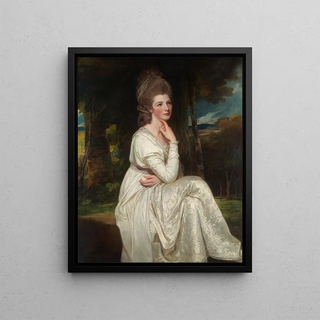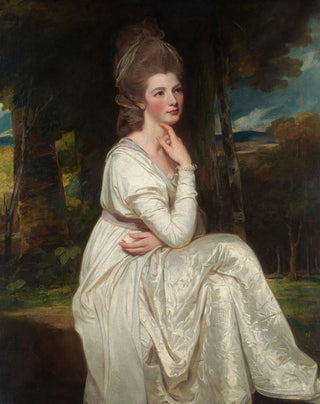Art print | Lady Elizabeth Stanley 1753-1797 Countess of Derby - George Romney


View from behind

Frame (optional)
Lady Elizabeth Stanley 1753-1797 Countess of Derby - George Romney – Captivating Introduction
In the fascinating world of 18th-century English painting, the artwork "Lady Elizabeth Stanley 1753-1797 Countess of Derby" by George Romney stands out for its elegance and refinement. This iconic depiction of an aristocratic figure embodies not only the timeless beauty of its subject but also the very essence of an era when art and society were deeply intertwined. The Countess of Derby, with her penetrating gaze and graceful pose, seems to capture the attention of anyone who crosses her path, inviting a deeper exploration of her history and legacy. This piece, both portrait and symbol, offers an immersion into a bygone world while resonating with universal emotions.
Style and uniqueness of the artwork
George Romney, master of the portrait, manages to transcend mere physical representation to capture the soul of his subjects. In this painting, light plays a crucial role, illuminating Lady Elizabeth's face while creating a subtle contrast with the shadows that envelop her body. The meticulous details of her dress, adorned with rich textures, testify to the artist's exceptional craftsmanship and his attention to the clothing elements that define the social status of the countess. The composition, carefully balanced, guides the viewer's gaze toward the noble lady's face, where nuances of color and play of light reveal rare psychological depth. This portrait does not merely depict a woman of high society; it evokes a complex personality, full of life and mystery, capturing a frozen moment in time.
The artist and his influence
George Romney, born in 1734, is often regarded as one of the greatest portraitists of his era. His career, marked by a constant pursuit of perfection, allowed him to establish a reputation within a thriving artistic circle, where he mingled with emblematic figures of his time. Influenced by European masters, notably Gainsborough and Reynolds, Romney developed a unique style, blending realism and idealization. His innovative approach to portraiture not only redefined the aesthetic standards of his time

Matte finish

View from behind

Frame (optional)
Lady Elizabeth Stanley 1753-1797 Countess of Derby - George Romney – Captivating Introduction
In the fascinating world of 18th-century English painting, the artwork "Lady Elizabeth Stanley 1753-1797 Countess of Derby" by George Romney stands out for its elegance and refinement. This iconic depiction of an aristocratic figure embodies not only the timeless beauty of its subject but also the very essence of an era when art and society were deeply intertwined. The Countess of Derby, with her penetrating gaze and graceful pose, seems to capture the attention of anyone who crosses her path, inviting a deeper exploration of her history and legacy. This piece, both portrait and symbol, offers an immersion into a bygone world while resonating with universal emotions.
Style and uniqueness of the artwork
George Romney, master of the portrait, manages to transcend mere physical representation to capture the soul of his subjects. In this painting, light plays a crucial role, illuminating Lady Elizabeth's face while creating a subtle contrast with the shadows that envelop her body. The meticulous details of her dress, adorned with rich textures, testify to the artist's exceptional craftsmanship and his attention to the clothing elements that define the social status of the countess. The composition, carefully balanced, guides the viewer's gaze toward the noble lady's face, where nuances of color and play of light reveal rare psychological depth. This portrait does not merely depict a woman of high society; it evokes a complex personality, full of life and mystery, capturing a frozen moment in time.
The artist and his influence
George Romney, born in 1734, is often regarded as one of the greatest portraitists of his era. His career, marked by a constant pursuit of perfection, allowed him to establish a reputation within a thriving artistic circle, where he mingled with emblematic figures of his time. Influenced by European masters, notably Gainsborough and Reynolds, Romney developed a unique style, blending realism and idealization. His innovative approach to portraiture not only redefined the aesthetic standards of his time






